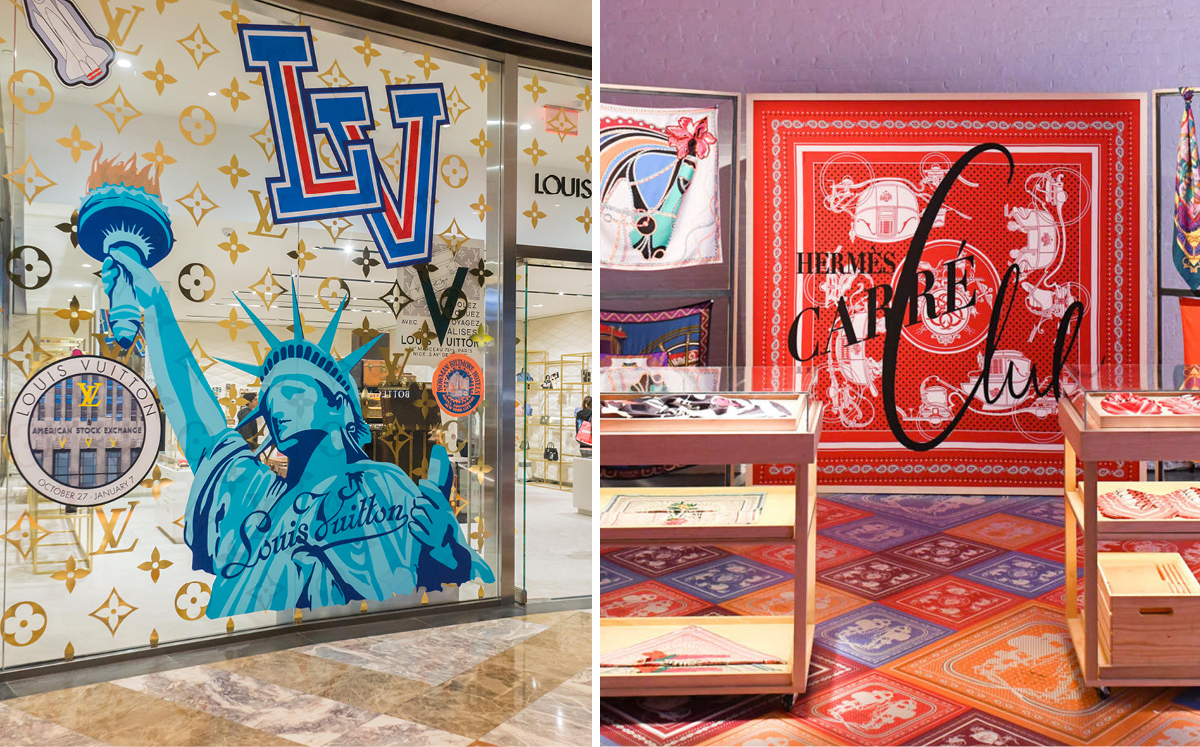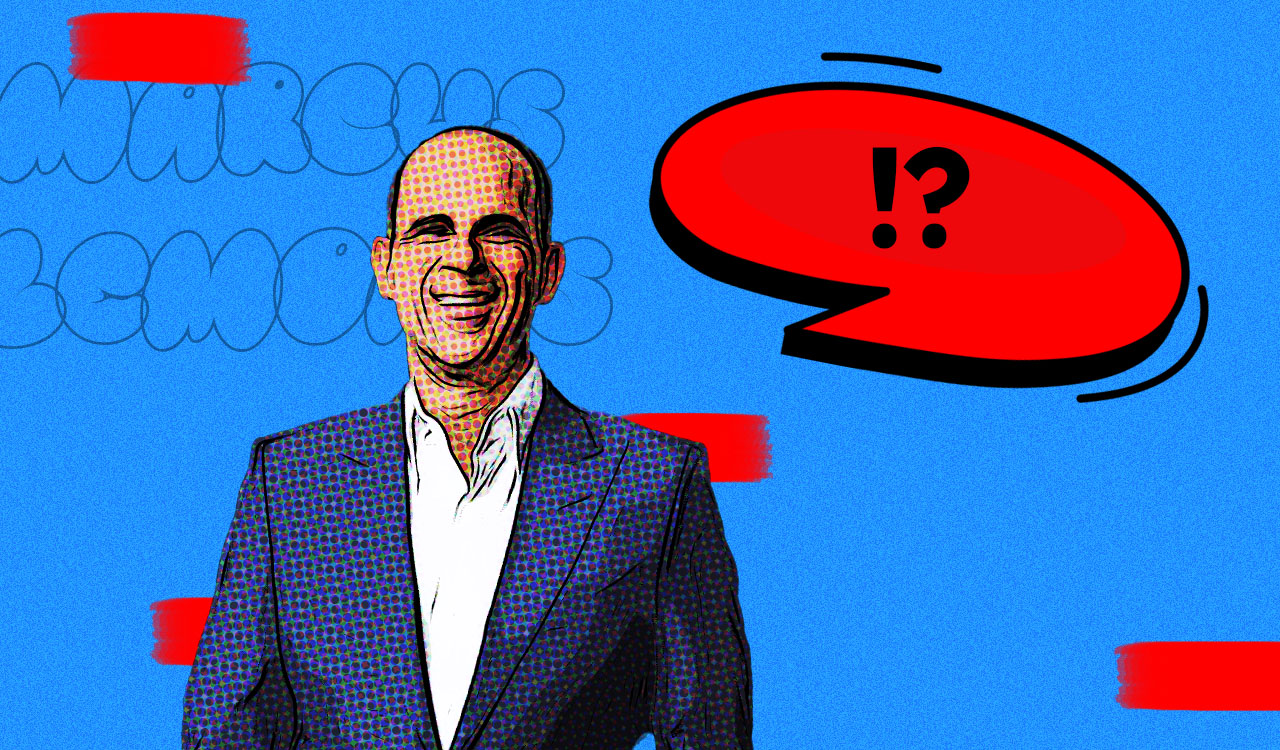I recently visited the Hermès Carre Club in the Meatpacking District of New York. I became a member of the \”Club,\” which existed for four days, by signing in (my data capture) with a team of Hermès clad concierges. In exchange, I wandered through the immersive experience replete with Instagrammable installations. I had the option of having my portrait drawn, watching a scarf designer execute a new design or listening to a Hermès designer discuss the creative process behind the renowned scarves. The Club had the requisite bar, which offered branded bags of sweets, sandwiches, espresso drinks and iced teas custom mixed by a tea-tender. The only route to the exit was through the scarf shop. The cash register was frenzied even though only one heavily branded scarf was exclusive to the event; the bulk of the merchandise was an edited selection of scarves available at any Hermès boutique or online.
The Carre Club, a highly-curated customer experience, bore some similarities to the Louis Vuitton Voulez, Vougez, Voyagez exhibition celebrating its heritage, luxury brand. While the scarf shop at the Carre Club rendered the event more commercial than the LV exhibition, there was no requisite monetary exchange for either event.
The lack of money flowing into New York City\’s anemic retail real estate landscape has aided the current explosion of pop-ups. In a recent interview on National Public Radio, Mohamed Haouache, CEO of Storefront, a New York based pop-up real estate and design consultancy said, everyone\’s using pop-ups, from small internet retailers to large companies like Facebook. \”We\’ve seen, also, a big push coming from luxury brands. We worked in the past with Chanel. And we\’ve seen a lot of celebrities, you know, like singers and performers launching their own brand.\” Storefront is part of a nascent pop-up supply chain that offers online retailers, tech companies, and venerated brands a guide on all things in pop-up. Haouache says as recently as five years ago, many landlords would rather sit on a vacant property for a year than entertain a short-term lease. But now he says more owners are seeing the upside of getting rent from a pop-up store.
Who is Popping?
LVMH may know more about popping corks than pop-up shops, but the Louis Vuitton branch of the family has had a consistent pop-up presence in New York City. In 2018 the brand progressed from the Volez, Voguez, Voyagez exhibition to the Ugly Shoe pop-up in February, highlighting the Nicolas Ghesqiere\’s Archlight sneaker, MASTERS, a pop-up presenting the Jeff Koons collaboration, a fragrance pop-up in Rockefeller Center, the LV Summer Trunk Hawaii pop-up, Grace Coddington Catogram pop-up and they are currently popped on Prince Street with a temporary men\’s shop.
LVMH brethren, Dior has popped-up in a four-story building in the Meatpacking district. The shop, which opened to celebrate the launch of Dior\’s e-commerce site, displays a complete offering of men\’s, women\’s and children\’s apparel, handbags, as well as specialty homewares. The setting, more a witty and compelling display of merchandise than a queue-up type of experience, is in keeping with brand culture. Dior CEO Pietro Baccari was interviewed by WWD at the opening and described the customer experience as akin to a visit to Marché aux Puces, the Clingancourt flea market at the edge of Paris.
Moving across the aisle to Richemont\’s holding Cartier, the brand recently closed the doors on their flower-filled jewel of a pop-up on Wooster Street in Soho. The mission of the shop was the introduction of the Carat fragrance, the scent that metaphysically \”smells like a shiny diamond.\” There were many energetic sales associates and the central entertainment of the shop, was the Mille Facettes, an audio-sensory experience held in a diamond-shaped cocoon. There were also photogenic set-ups and a \”mantra\” wall where you could grab a colored fortune cookie sized inspirational note.
Not to be left out, independent brand Moncler is taking advantage of a vacant Soho storefront by opening their temporary House of Genius, selling limited edition, brilliant coat-gowns from a collaborative collection created by multiple designers including Valentino\’s creative director Pierpaolo Piccioli and Simone Rocha. You can also choose from a selection of limited-edition exclusive pieces including a range of vintage duvet patchwork blankets, a customized snowboard crafted by Burton, or pet accessories by Poldo Dog Couture.
What\’s the Strategy?
Wandering into these outposts, knowing that these luxury brands already have a significant retail footprint in place, have opened their doors to customers and the city, I couldn\’t help but ponder the cost-benefit and the marketing objectives of these elaborate efforts. Some pop-ups feel like bespoke retail plays, looking to simply boost annual revenue numbers or execute a scarcity marketing strategy. Others can be looked at as a retail beta or prototype to test out new products and ideas with a different audience. In a recent article in The Atlantic, Melissa Gonzalez, the founder of the Lion\’esque Group, a pop-up strategy and design firm said, \”many of her clients are looking to position their pop-ups more as intelligence outposts than traditional stores with inventory. \”Pop-ups are tripped out with tracking sensors and data points that offer brands experiential data tracking not available through other sales channels. The concentration of clientele in a short-term pop-up offers a density of data that is difficult to accumulate in a traditional retail setting.
The value of in-person data tracking was detailed in a recent interview with Jeff Gennette as he described Macy\’s Market Concept at the 2018 Code Commerce conference. While the Macy\’s 34th Street flagship store would hardly be considered nontraditional, Gennette detailed the retailer\’s Market Concept, which has the soul of a pop-up housed in a traditional flagship setting. Gennette said: \”It is a roving caravan of product. Product will be there for two weeks. If you are a customer, you are going to come into this space and you are going to see 20 different things. You can come back two weeks later and you will see different things. We record all of this activity on how they shop: what the hot spots of that brand are and what features and benefits stymie them. Then we give the feedback on the brand so that they can learn to be better.\” This IRL (in real life) data harvested from human interactions offer customer insights more valuable than studying only clicks and cart abandonment. The understandings have more context in a concentrated, in-person setting.
Beyond New York City
The pop-up-ification of retail is not limited to New York. A simple online query results in a compelling array of pop-ups in Tokyo, Seoul, Milan, London, and Paris over the past year. Particularly eye-catching was a North Face pop-up activation held this past summer in Sal Van Nicolò Italy, off a hiking trail accessible only by foot.
What is the Role of Pop-Ups in Omnichannel Retail?
While pop-ups may lack the density to hold their own as a stand-alone channel in our omnichannel retail environment, they are playing an interesting role. They offer brands a beta testing lab, facilitate an instant client feedback loop, affirm a brand\’s marketing strategy, and for a luxury brand, they offer a physical connection from the atelier to an online shopping experience, as was demonstrated through Dior\’s pop-up celebrating the house\’s entrée to ecommerce. With limited inventory or, in some cases, no inventory at all (simply online purchase portals), pop-ups may actually define the modern embodiment of omnichannel retail.




